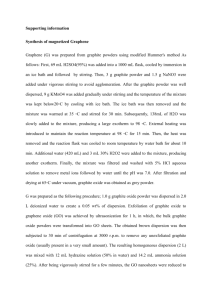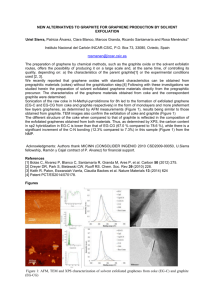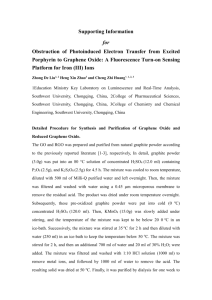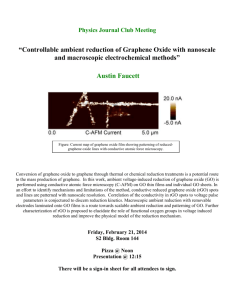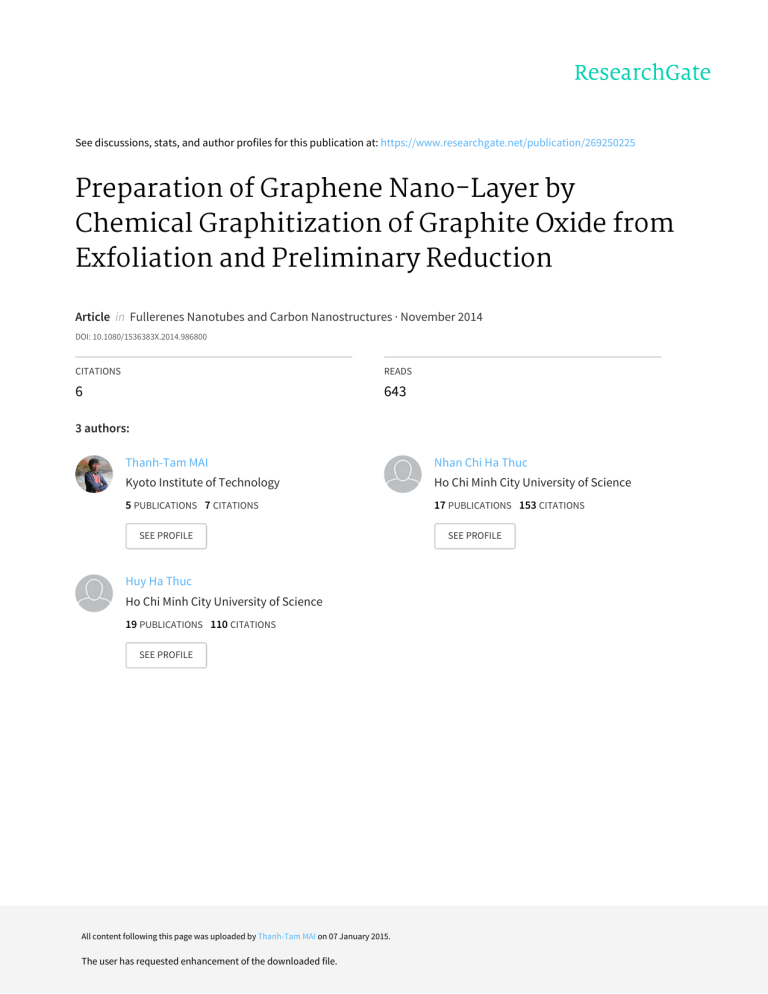
See discussions, stats, and author profiles for this publication at: https://www.researchgate.net/publication/269250225 Preparation of Graphene Nano-Layer by Chemical Graphitization of Graphite Oxide from Exfoliation and Preliminary Reduction Article in Fullerenes Nanotubes and Carbon Nanostructures · November 2014 DOI: 10.1080/1536383X.2014.986800 CITATIONS READS 6 643 3 authors: Thanh-Tam MAI Nhan Chi Ha Thuc Kyoto Institute of Technology Ho Chi Minh City University of Science 5 PUBLICATIONS 7 CITATIONS 17 PUBLICATIONS 153 CITATIONS SEE PROFILE Huy Ha Thuc Ho Chi Minh City University of Science 19 PUBLICATIONS 110 CITATIONS SEE PROFILE All content following this page was uploaded by Thanh-Tam MAI on 07 January 2015. The user has requested enhancement of the downloaded file. SEE PROFILE This article was downloaded by: [Kyoto Kogei Seni University], [Mai Thanh Tam] On: 06 January 2015, At: 21:07 Publisher: Taylor & Francis Informa Ltd Registered in England and Wales Registered Number: 1072954 Registered office: Mortimer House, 37-41 Mortimer Street, London W1T 3JH, UK Fullerenes, Nanotubes and Carbon Nanostructures Publication details, including instructions for authors and subscription information: http://www.tandfonline.com/loi/lfnn20 Preparation of Graphene Nano-Layer by Chemical Graphitization of Graphite Oxide from Exfoliation and Preliminary Reduction a b a Tam T. Mai , Chi Nhan Ha Thuc & Huy Ha Thuc a Department of Polymer Chemistry, Faculty of Chemistry, University of Science, National University of Ho Chi Minh City (VNU-HCM), 227, Nguyen Van Cu, District 5, Ho Chi Minh City, Vietnam b Faculty of Materials Science, University of Science, National University of Ho Chi Minh City (VNU-HCM), 227, Nguyen Van Cu, District 5, Ho Chi Minh City, Vietnam Accepted author version posted online: 18 Nov 2014.Published online: 03 Jan 2015. Click for updates To cite this article: Tam T. Mai, Chi Nhan Ha Thuc & Huy Ha Thuc (2015) Preparation of Graphene Nano-Layer by Chemical Graphitization of Graphite Oxide from Exfoliation and Preliminary Reduction, Fullerenes, Nanotubes and Carbon Nanostructures, 23:8, 742-749, DOI: 10.1080/1536383X.2014.986800 To link to this article: http://dx.doi.org/10.1080/1536383X.2014.986800 PLEASE SCROLL DOWN FOR ARTICLE Taylor & Francis makes every effort to ensure the accuracy of all the information (the “Content”) contained in the publications on our platform. However, Taylor & Francis, our agents, and our licensors make no representations or warranties whatsoever as to the accuracy, completeness, or suitability for any purpose of the Content. Any opinions and views expressed in this publication are the opinions and views of the authors, and are not the views of or endorsed by Taylor & Francis. The accuracy of the Content should not be relied upon and should be independently verified with primary sources of information. Taylor and Francis shall not be liable for any losses, actions, claims, proceedings, demands, costs, expenses, damages, and other liabilities whatsoever or howsoever caused arising directly or indirectly in connection with, in relation to or arising out of the use of the Content. This article may be used for research, teaching, and private study purposes. Any substantial or systematic reproduction, redistribution, reselling, loan, sub-licensing, systematic supply, or distribution in any form to anyone is expressly forbidden. Terms & Conditions of access and use can be found at http:// www.tandfonline.com/page/terms-and-conditions Fullerenes, Nanotubes and Carbon Nanostructures (2014) 23, 742–749 Copyright 2014 Taylor & Francis Group, LLC ISSN: 1536-383X print / 1536-4046 online DOI: 10.1080/1536383X.2014.986800 Preparation of Graphene Nano-Layer by Chemical Graphitization of Graphite Oxide from Exfoliation and Preliminary Reduction Downloaded by [Kyoto Kogei Seni University], [Mai Thanh Tam] at 21:07 06 January 2015 TAM T. MAI1, CHI NHAN HA THUC2 and HUY HA THUC1 1 Department of Polymer Chemistry, Faculty of Chemistry, University of Science, National University of Ho Chi Minh City (VNUHCM), 227, Nguyen Van Cu, District 5, Ho Chi Minh City, Vietnam 2 Faculty of Materials Science, University of Science, National University of Ho Chi Minh City (VNU-HCM), 227, Nguyen Van Cu, District 5, Ho Chi Minh City, Vietnam Received 9 June 2014; accepted 9 November 2014 This study is a development method of exfoliation and preliminary reduction of graphite oxide (GO) by polyethylene glycol (PEG). The results of modified GO (MGOPEG) had not shown the crystalline peak d002 on X-ray diffraction patterns and took the form of a single layer graphene oxide on the images of atomic force microscopy. Also, MGOPEG had a higher heat resistance than GO because of preliminary reduction. Finally, the exfoliated GO (graphene oxide) was reduced to graphene by the reducing agent system of hydrogen iodide in acetic acid to form graphene (RGOHI-AcOH). The results showed the disappearing of exothermic peak on the Differential Scanning Calorimetry curve of RGOHI-AcOH and graphite while a wide exothermic peak was found around 245 C with DH D ¡1505.86 J/g and 198 C with DH D ¡482.09 J/g of GO and MGOPEG respectively. The same results were shown with thermogravimetric analysis. In addition, Fourier transform infrared, ultraviolet-visible, and Raman spectra showed more clearly the characteristics of GO, MGOPEG, and RGOHI-AcOH. The sheet resistance of RGOHI-AcOH is about 120 V/& (with 1.66 £ 103 S m¡1 of conductivity) in the thin film formed on cellulose acetate substrate. Keywords: graphite oxide, polyethylene glycol, modified graphite oxide, exfoliated graphite oxide, reduced graphene oxide 1. Introduction Graphene can be made in different ways as mechanical exfoliation from graphite (1–3), chemical vapor deposition (CVD) (4), and reduction of graphene oxide (5–8). In particular, graphene, which was made from graphite oxide (GO), has diverse applications in different fields, especially in the field of polymer nanocomposites. Graphite oxide was synthesized by oxidation of graphite with strong oxidizing agents such as KMnO4, KNO3, and KClO3 in acid conditions. The most common method since 1958 has been the use of the redox of KMnO4, KNO3, and H2SO4 from the Hummers studies. Graphite oxide was attached to the surface of polar groups such as hydroxyl, epoxy, carbonyl, and carboxylic. Based on these polar groups, the distance between two layers of GO is raised from 3.3 to 8.0 A (9). This is an opportunity Address correspondence to Prof. Huy Ha Thuc, Department of Polymer Chemistry, Faculty of Chemistry, University of Science, National University of Ho Chi Minh City (VNU-HCM), 227, Nguyen Van Cu, District 5, Ho Chi Minh City, Vietnam. E-mail: hthuy@hcmus.edu.vn Color versions of one or more of the figures in the article can be found online at www.tandfonline.com/lfnn. to insert the modified compound between GO layers to exfoliate the layers of graphene oxide. The GO layer structure can be intercalated by the compound with chemical or physical interactions. In chemical interaction, the isocyanate compound was commonly used because ( NCO) groups can easily react with ( OH), ( COOH), and epoxide groups on GO surface (10). In addition, compounds of amino, amino acid, and silane (11) are also used as coupling and intercalating agents. However, if GO and modifier agent had interacted together by chemical bonds, the following reduction of GO may become more difficult (12). So the exfoliated method of GO of surface-active compounds is preferred to be used. The non-ionic surfactant is also considered to interact strongly with GO in several studies. The modified graphite with oxide was then easily exfoliated with the aid of ultrasonic radiation. The exfoliated GO is called graphene oxide, which is continuously reduced by the reducing agent to form reduced graphene oxide (RGO). The reducing agents used in such cases are hydrazine (NH2-NH2) (13–15), sodium borohydride (NaBH4) (16), alcohol (17), bacteria (5), thermal reductions (18, 19), and others. In recent years, hydrogen iodide (HI; hydriodic acid) has been used as a reducing agent as reported in some papers (8, 20). In particular, Cataldo et al. (21) reported that HI is an effective reducing agent in the reduction of GO. Downloaded by [Kyoto Kogei Seni University], [Mai Thanh Tam] at 21:07 06 January 2015 Graphene Nano-Layer by Chemical Graphitization of Graphite Oxide Our study is a continuation of Cataldo et al.’s paper (21). In our study, modified and exfoliated GO with polyethylene glycol (MGOPEG) was used as original source instead of GO as used by previous authors. Polyethylene glycol (PEG) was used not only as a modified agent to exfoliate GO but also as a preliminary reduced agent for GO because of its OH groups (17). MGOPEG was continuous with the last reduction by HI/CH3COOH mixture. In addition, the properties of MGOPEG and reduced graphene oxide by HI-AcOH (RGOHI-AcOH) were further clarified through various analytical methods such as Fourier transform infrared (FT-IR), Raman, and ultraviolet-visible spectroscopy (UV-vis) spectra, transmission electron microscopy (TEM), atomic force microscopy (AFM), thermogravimetric analysis (TGA), differential scanning calorimetry (DSC), and electric conductivity. 2. Experimental 2.1. Materials Graphite flake and PEG with Mw D 1500 g/Mol (PEG) was purchased from Sigma Aldrich and used without further purification. Sulfuric acid (95–97 wt.%), hydrogen peroxide (30 wt.%), potassium permanganate, sodium nitrate, hydrogen iodide acid (57 wt.%), acetic acid, sodium bicarbonate, and basic solvents were obtained from commercial sources and used as received. 743 ultrasonically dispersed in distilled water (1000 ml) by using ultrasonic aluminum horn (tip diameter D 13 mm) of UP400S (Germany) for 30 min. Then the suspension of GO was transferred to 1500-ml flask having 5.0 ml of NH3 solution (35 wt.%). After adding 10.0 g of PEG, the suspension was vigorously stirred for 24 h. The modified GO (MGOPEG) was then split into single-layer graphene oxide under the effect of ultrasound within 30 min. Finally, the product was deposited with a solution of HCl (5 wt.%), then filtered by vacuum and washed for many times with a mixture of acetone-water (50/50 by volume) to remove residue of PEG and NH3. Then it was dried in vacuum at 60 C. 2.4. Reduction of MGO by Mixture of HI and CH3COOH (HI-AcOH) System The reduction process was prepared by chemical graphitization. Accordingly, 2.0 g of MGOPEG was dispersed in 750 ml of acetic acid using LT-60H ultrasonic bath cleaner (35 kHz) for 1 h. Then 40 ml of iodic acid (50%) was added and the suspension was continuously sonicated for 30 min before being stirred for 40 h at 40 C. The product was finally filtered and washed for five times with 100 ml of sodium bicarbonate solution (5 wt.%) to neutralize HI of residue in mixture and following with 100 ml of distilled water (for five times) and 100 ml of acetone (twice) to ensure that this removes most of other impurities in the reduced product. Then it was dried in vacuum at 80 C for 24 h. 2.2. Preparation of Graphite Oxide 2.5. Fabrication of GO, MGOPEG, and RGOHI-AcOH Films Graphite oxide was prepared from graphite flake using the modified Hummers and Offemman’s method with acid sulfuric, sodium nitrate, and potassium permanganate. Accordingly, 10-g graphite, 0.5 g of NaNO3, and 230 ml of H2SO4 (98%) were placed in 2500-ml four-neck flask. The mixture was stirred and cooled at 0 C. Then 300 g of KMnO4 was added slowly to the system (taking care that temperature of the suspension must not exceed 20 C). Next the temperature of the system was raised to 35 § 2 C in 30 min for graphite oxidation. After reaction, the suspension was diluted with 460 ml of distilled water and raised to 98 C for 15 min. At this time, the suspension system continues to be diluted with 1400 ml of distilled water, and 500 ml of H2O2 (30 wt.%) was added to the mixture to remove residual KMnO4 and other impurities. After treatment with hydrogen peroxide, the reaction mixture became bright yellow in color. The product (GO) was finally centrifuged, washed with solution of HCl (5 wt.%) to remove all residual ions of SO42¡ (identified by BaCl2 solution). Then acetone was used to remove chloride acid and other impurities in GO. Finally, the product is dried in vacuum at 60 C. Thin films of GO, MGOPEG, and RGOHI-AcOH on the filter paper substrate with 0.45 mm of hole size (cellulose acetate) were carried out by using vacuum filtration method. Accordingly, 0.02 g of RGOHI-AcOH was dispersed in 200 ml of 2.3. Exfoliation and Preliminary Reduction of Graphite Oxide Graphite oxide was modified by PEG with a molecular weight of 1500 g/Mol. Accordingly, 1.0 g of GO was Fig. 1. FT-IR spectra of graphite, graphite oxide (GO), modified GO (MGO), and RGOHI-AcOH. Downloaded by [Kyoto Kogei Seni University], [Mai Thanh Tam] at 21:07 06 January 2015 744 Mai et al. Fig. 2. UV-Vis spectra and suspensions of GO, MGOPEG, and RGOHI-AcOH. (1) GO in water (1.0 mg/100 ml of H2O), (2) MGOPEG in water (1.0 mg/100 ml of H2O), (3) RGOHI-AcOH in solution of SDS 0.5 w.% (1.0 mg/100 ml of SDS). sodium dodecyl sulfate (SDS) solution (1.0 wt.%) by using ultrasonic aluminum horn for 2 h. Next, the suspension was centrifuged for 30 min, decanting the upper suspension of monolayer and removing the layer that was not exfoliated. The GO and MGOPEG suspensions were made similar to RGOHI-AcOH but the SDS solution was replaced by distilled water. Then all of these were filtered and washed with distilled water to remove all SDS present in the film (in the case of suspension of RGOHI-AcOH) at low pressure. The film was dried and pressed with a weight of 5 kg at 80 C for 24 h (Figure 9). 2.6. Characterizations The morphology of MGOPEG and RGOHI-AcOH samples dispersed in dimethylformamide (DMF, 0.5 mg/ml) for 2 h by using ultrasonic aluminum horn was studied by ATM (3100 Veeco) using a silicon cantilever operated in tapping mode at room temperature. The spectroscopic sample structure analysis was carried out by using a Fourier transform infrared spectrometer (FT-IR, Equinox 55), Raman spectrometer (Horiba Jobiny, laser at 632 nm), and UV-Vis (NIR V670 spectrometer). Thermal and thermodynamic properties of GO, RGOHI-AcOH, and MGO were studied using TGA Q500 and DSC Stare SW 11.00 with the same condition at a rate of Fig. 3. Raman spectra of graphite, GO, MGOPEG, and RGOHIAcOH. 20 C/min from room temperature to 400 C (for DSC) and 600 C (for TGA) in continuous nitrogen flow. The thickness and sheet resistance (RS) of GO, MGOPEG, and RGOHIAcOH papers were measured using a stylus profilometer with 3 mg force (Dektak 6M, Veeco) and a four-point probe resist meter (CTM-100 MP, Advanced Instrument Technology). 3. Results and Discussion 3.1. Spectroscopic Characteristics of MGOPEG and RGO FT-IR spectra of graphite, GO, MGO, and RGOHI-AcOH are shown in Figure 1. Oxygen functional groups of GO powder were observed via stretching peaks at »1720 cm¡1 (CDO), a broad band at »2431–3722 cm¡1 (O H of hydrogen bonds of GO or adsorbed water), C OH or C O C (epoxide) at »1100 cm¡1. In addition, the peak stretching at »1624 cm¡1 assigned to the skeletal vibration of unoxidized graphitic domains or contribution from the stretching deformation vibration of intercalated water (22). After modification with PEG, the oxygen peaks of MGOPEG were lower than GO, suggesting the ability to preliminary reduction of PEG (with the groups of OH as reducing agents) (17). Figure 1 also showed the dramatic decrease of peaks of oxygen functional groups in the RGOHI-AcOH. This is the result of the restoration of electronic conjugation within platelets (8, 21). In addition, the signals at »2350 cm¡1 in the FT-IR spectrum of GO were assigned to CO2 intercalated between layers. This Table 1. Characterization of XRD and Raman spectra of graphite, GO, MGOPEG, and RGOHI-AcOH XRD Samples Graphite oxide MGOPEG RGOHI-AcOH Graphite Raman 2u at d002 ( ) d-spacing (nm) D-band (cm¡1) G-band (cm¡1) ID/IG (%) 11.3 — — 26.4 0.779 — — 0.333 1325.7 1332.4 1332.5 1324.4 1586.2 1598.5 1598.5 1568.2 1.24 1.35 1.36 0.10 Downloaded by [Kyoto Kogei Seni University], [Mai Thanh Tam] at 21:07 06 January 2015 Graphene Nano-Layer by Chemical Graphitization of Graphite Oxide Fig. 4. Powder XRD patterns of graphite, GO, MGOPEG, and RGOHI-AcOH. peak was very small for MGOPEG and RGOHI-AcOH. The result demonstrated exfoliated structure of MGOPEG and RGOHI-AcOH, so adsorption of CO2 was more difficult (confirmed in the XRD patterns in Section 3.2). The UV-Vis spectra (Figure 2) of GO dispersion in water also showed strong absorption bands at »224 nm (from the p-plasmon of carbon) and a shoulder peak at »300 nm (from the n Ò p* transitions of CDO) (8). The large peaks of Fig. 5. AFM images of (a) MGOPEG and (b) RGOHI-AcOH. 745 MGOPEG and RGOHI-AcOH have moved to 260 and 266 nm respectively, indicating the restoration of electronic conjugation within MGO and RGOHI-AcOH layers (23). Besides, the shoulder peak was disappearing with MGO and RGO; this suggests that the CDO groups were completely reduced by PEG and HI-AcOH. Figure 3 presents the Raman spectra of graphite layers, GO, MGOPEG, and RGOHI-AcOH in powder form. The peaks for GO, MGOPEG, and RGOHI-AcOH at the G-band moved to the high frequency area compared with that of graphite. This was attributed to the presence of isolated double bonds that resonate at frequencies higher than that of the G-band of graphite (8). The peak at D-band of GO, MGOPEG, and RGOHI-AcOH was higher than graphite. Table 1 also showed that the ID/IG ratio of RGOHI-AcOH (1.36) is higher than that of GO (1.23), MGOPEG (1.35), and graphite (0.10). This result is because the reduction process altered the structure of GO with a high quantity of structural defects (24). The peaks at 2D-bands of RGOHI-AcOH, GO, and MGOPEG are not clearly compared with the original graphite. So this is an inconvenient point of chemical way to reduce GO, which corresponds to the hard way to recover the hexagonal network of carbon atoms with defects. 3.2. Structure and Morphology of All Samples Figure 4 show the X-ray diffraction pattern of graphite, GO, interMGOPEG, and RGO HI-AcOH. The GO has a larger layer spacing (7.79 A) than that of graphite (3.33 A) because Downloaded by [Kyoto Kogei Seni University], [Mai Thanh Tam] at 21:07 06 January 2015 746 Mai et al. Fig. 6. TEM images of (a) MGOPEG and (b) RGOHI-AcOH. Fig. 7. Decomposition behavior of graphite, GO, MGO, and RGOHI-AcOH shown through TGA curve ((a) weight loss and (b) derivative weight as variation of temperature). Table 2. Thermal properties of graphite, GO, MGOPEG, and RGOHI-AcOH TGA Samples Graphite oxide MGOPEG RGOHI-AcOH Graphite DSC Temperature ( C) Weight loss (%) Tpeak ( C) (exothermic) DH (J/g) 50–150 150–450 450–700 50–150 150–450 450–700 50–150 150–450 450–700 50–150 150–450 450–700 7.73 38.97 6.21 10.70 24.41 3.49 0.84 1.38 10.27 0.44 0.90 0.88 245.07 ¡1505.86 198.20 ¡482.09 — — — — Graphene Nano-Layer by Chemical Graphitization of Graphite Oxide 747 RGOHI-AcOH has also been chopped under the effect of reduction. The stronger reduction will lead to the smaller size of RGO. Downloaded by [Kyoto Kogei Seni University], [Mai Thanh Tam] at 21:07 06 January 2015 3.3. Thermal and Thermodynamic Properties Fig. 8. DSC curves of GO, MGOPEG, RGOHI-AcOH, and graphite. of oxygen functional groups and the water held in interlayer galleries by the hydrogen bonds of GO (25). With MGOPEG and RGOHI-AcOH, the characteristic peak at 2u D 11.3o disappeared in the XRD patterns, indicating the breakdown of crystal structure compared with GO (Table 1). This proves that MGOPEG and RGOHI-AcOH were exfoliated into individual platelets and agglomerated into a powder form. The AFM images of MGO (Figure 5(a)) showed singlelayer graphene oxide with a thickness of 1.050 nm and a diameter of about 1000 nm. Besides, Figure 5(b) shows the morphology of RGOHI-AcOH with a thickness of 1.605 nm and a diameter of about 500 nm. In addition, TEM images in Figures 6(a) and (b) also confirmed the exfoliated structure of MGO and RGOHI-AcOH with a lot of single layers. This demonstrates that both MGOPEG and RGO samples reach exfoliated structure and are similar to XRD result. However, RGOHI-AcOH is easier to agglomerate than MGOPEG, and Thermogravimetric analysis curves in Figure 7 and Table 2 show the weight loss profiles of powder samples as variations of temperature under N2 flow. Weight loss of GO (7.7%) and MGOPEG (10%) at 50–150 C could be primarily due to the evaporation of water molecules absorbed in the samples, while RGOHI-AcOH has no weight loss, similar to graphite because RGO and graphite are completely hydrophobic with the disappearance of polar (oxygen) groups. At higher temperatures of 150–450 C, the degradation stage of MGO (24.5%) occurred at 190 C, lower than GO (40%) at 210 C. This is the result of the release of water, CO, and CO2 of thermal reduction of oxygen functional groups (26, 27) and the ability to preliminary reduce PEG, also clarified again here. Also, RGOHI-AcOH sample showed much higher thermal stability with a weight loss of 1.38 wt.% when the temperature reaches 150–450 C, and this thermal behavior is similar to that of graphite because of the better graphitization and deoxygenation of RGOHI-AcOH, which enhanced Van der Waals forces between layers (8, 21). In addition, the degradation of carbon skeleton with temperature range from 450 to 700 C. Because of the effect of reduction, RGOHI-AcOH was shredded and formed many defects and this is the cause of 10.27% degradation of RGOHI-AcOH (more than others). Similar to TGA curve, DSC curves of GO, MGOPEG, RGOHI-AcOH, and graphite with a heating rate of 20 C/min are shown in Figure 8. Large exothermic peaks of GO and MGOPEG were found at the around 245 C (DH D ¡1505.86 J/g) and 198 C (DH D ¡482.09 J/g) respectively (Table 2). During exothermic reaction, CO, H2O, and CO2 were Fig. 9. Fabrication process of GO, MGOPEG, and RGOHI-AcOH paper by low pressure filtration method. 748 Downloaded by [Kyoto Kogei Seni University], [Mai Thanh Tam] at 21:07 06 January 2015 degased with 167 kJ/mol (1.73 eV/atom) of activation energy calculated by Yin et al. (28) or 155 kJ/mol (1.6 eV/ atom) by Jung et al. (27). Exothermic enthalpy of GO is 3.12 times larger than MGOPEG. In the case of RGOHI-AcOH, we did not see any signal on DSC curve, which showed that reduction of MGOPEG (or GO) was occurring almost completely. A point to note, these results are similar to the conclusions from FT-IR and UV-vis spectra and TGA although we noticed a difference of temperature at peak between TGA and DSC. 3.4. Conductivity of MGOPEG and RGO The conductivity and sheet resistance of RGOHI-AcOH paper (»5.0 mm thickness, Figure 9) was 1.66 £ 103 S m¡1 (electrical conductivity D 1/(thickness £ sheet resistance) and 120 V/& respectively, while GO and MGOPEG are non-conductive (with very large sheet resistance). Graphite oxide and MGOPEG are not conjugated electronic structures with many of Csp3 and defects on monosheets, so they are not conductive even with a preliminary reduction of MGO by hydroxyl groups of PEG. In addition, the hydroxyl index of PEG (1500 g/mol) is lower than any other type of alcohol, so its chemical reducing ability is weaker than other alcohol. Compared with MGOPEG, the high conductivity of RGOHI-AcOH was attributed to well restore electronic structure of layers exfoliated through reduction because HIAcOH is a strong reducing agent (8). 4. Conclusions Via morphological analysis, the study was considered to succeed in exfoliating GO to monolayer by using PEG as a modifier. Based on the spectrum and thermal analysis, these were shown preliminary reduction capabilities of PEG. In addition, RGOHI-AcOH obtained has a higher conductivity (1.66 £ 103 S m¡1) and much better thermal properties (similar to graphite) than GO and MGO. With the above results of MGO and RGOHI-AcOH, material is considered to be applied in the fields of electronic devices, organic solar cells, and polymer nanocomposites. Acknowledgments We gratefully acknowledge Applied Physical Chemistry Laboratory of Vietnam National University, Ho Chi Minh City (VNU-HCM) for the support of necessary equipment. Funding To complete this study, we gratefully acknowledge funding from the key projects (B2012-18-04TĐ) of Vietnam National University, Ho Chi Minh City (VNU-HCM). Mai et al. References 1. Novoselov, K. S., Geim, A. K., Morozov, S. V., Jiang, D., Zhang, Y., Dubonos, S. V., Grigorieva, I. V., and Firsov, A. A. (2004) Electric field effect in atomically thin carbon films. Science, 306 (5696): 666–669. 2. Green, A. A. and Hersam, M. C. (2009) Solution phase production of graphene with controlled thickness via density differentiation. Nano Lett., 9(12): 4031–4036. 3. Lotya, M., Hernandez, Y., King, P. J., Smith, R. J., Nicolosi, V., Karlsson, L. S., Blighe, F. M., De, S., Wang, Z., McGovern, T., Duesberg, G. S., and Coleman, J. N. (2009) Liquid phase production of graphene by exfoliation of graphite in surfactant/water solutions. J. Am. Chem. Soc., 131(10): 3611–3620. 4. Ren, Y., Zhu, C., Cai, W., Li, H., Hao, Y., Wu, Y., Chen, S., Wu, Q., Piner, R. D., and Ruoff, R. S. (2012) An improved method for transferring graphene grown by chemical vapor deposition. Nano, 7 (1): 1–6. 5. Everett, C. S., Zengzong, S., Andreas, L., and James, M. T. (2010) Reduction of graphene oxide via bacterial respiration. AcS Nano, 4 (8): 4852–4856. 6. Paul, H. and Mohanta, D. (2011) Hydrazine reduced exfoliated graphene/graphene oxide layers and magnetoconductance measurements of Ge-supported graphene layers. Appl. Phys. A, 103(2): 395–402. 7. Park, S., An, J., Potts, J. R., Velamakanni, A., Murali, S., and Ruoff, R. S. (2011) Hydrazine reduction of graphite and graphene oxide. Carbon, 49(9): 3019–3023. 8. Moon, I. K., Lee, J., Ruoff, R. S., and Lee, H. (2010) Reduced graphene oxide by chemical graphitization. Nature Commun., 1(6): 1–6. 9. Dimiev, A., Kosynkin, D. V., Alemany, L. B., Chaguine, P., and Tour, J. M. (2012) Pristine graphite oxide. J. Am. Chem. Soc., 134 (5): 2815–2822. 10. Stankovich, S., Piner, R., Nguyen, S. B., and Ruoff, R. S. (2006) Synthesis and exfoliation of isocyanate-treated graphene oxide nanoplatelets. Carbon, 44(15): 3342–3347. 11. Dreyer, D. R., Park, S., Bielawski, C. W., and Ruoff, R. S. (2010) The chemistry of graphene oxide. Chem. Soc. Rev., 39(1): 228. 12. Daniel, R. D., Sungjin, P., Christopher, W. B., and Ruoff, R. S. (2010) The chemistry of graphene oxide. Chem. Soc. Rev., 39: 228–240. 13. Peiying, Z., Ming, S., Shuhua, X., and Dong, Z. (2011) Experimental study on the reducibility of graphene oxide by hydrazine hydrate. Physica B, 406: 498–502. 14. Paul, H. and Mohanta, D. (2011) Hydrazine reduced exfoliated graphene/graphene oxide layers and magnetoconductance measurements of Ge-supported graphene layers. Appl. Phys. A, 103: 395–402. 15. Sungjin Park, J. A., Jeffrey, R. P., Velamakanni, A., Shanthi, M., and Ruoff, R. S. (2011) Hydrazine-reduction of graphite- and graphene oxide. Carbon, 49(9): 3019–3013. 16. Park, S. and Ruoff, R. S. (2009) Chemical methods for the production of graphenes. Nat Nanotechnol., 4(4): 217–224. 17. Dreyer, D. R., Murali, S., Zhu, Y., Ruoff, R. S., and Bielawski, C. W. (2011) Reduction of graphite oxide using alcohols. J. Mater. Chem., 21(10): 3443–3447. 18. Jung, I., Vaupel, M., Pelton, M., Piner, R., Dikin, D. A., Stankovich, S., An, J., and Ruoff, R. S. (2008) Characterization of thermally reduced graphene oxide by imaging ellipsometry. J. Phys. Chem. C, 112(23): 8499–8506. 19. Osv ath, Z., Darabont, A., Nemes-Incze, P., Horv ath, E., Horv ath, Z. E., and Bir o, L. P. (2007) Graphene layers from thermal oxidation of exfoliated graphite plates. Carbon, 45(15): 3022–3026. 20. Pei, S., Zhao, J., Du, J., Ren, W., and Cheng, H. M. (2010) Direct reduction of graphene oxide films into highly conductive and flexible graphene films by hydrohalic acids. Carbon, 48(15): 4466–4474. Downloaded by [Kyoto Kogei Seni University], [Mai Thanh Tam] at 21:07 06 January 2015 Graphene Nano-Layer by Chemical Graphitization of Graphite Oxide 21. Cataldo, F., Ursini, O., and Angelini, G. (2011) Graphite oxide and graphene nanoribbons reduction with hydrogen iodide. Fullerenes Nanotubes Carbon Nanostruct., 19(5): 461–468. 22. Guo, H. L., Wang, X. F., Qian, Q. Y., Wang, F. B., and Xia, X. H. (2009) A green approach to the synthesis of graphene nanosheets. ACS Nano, 3(9): 2653–2659. 23. Li, D., M€ uller, M. B., Gilje, S., Kaner, R. B., and Wallace, G. G. (2008) Processable aqueous dispersions of graphene nanosheets. Nat Nanotechnol., 3(2): 101–105. 24. Kudin, K. N., Ozbas, B., Schniepp, H. C., Prudhomme, R. K., Aksay, I. A., and Car, R. (2008) Raman spectra of graphite oxide and functionalized graphene sheets. Nano Lett., 8(1): 36–41. 25. Medhekar, N. V., Ramasubramaniam, A., Ruoff, R. S., and Shenoy, V. B. (2010) Hydrogen bond networks in graphene oxide View publication stats 749 composite paper: structure and mechanical properties. ACS Nano, 4(4): 2300–2306. 26. Eigler, S., Dotzer, C., Hirsch, A., Enzelberger, M., and M€ uller, P. (2012) Formation and decomposition of CO2 intercalated graphene oxide. Chem. Mater., 24(7): 1276–1282. 27. Jung, I., Field, D. A., Piner, R. D., Clark, N. J., Stankovich, S., Carl, A. V. J., Zhu, Y., Dikin, D. A., Ruoff, R. S., Yang, D., and Geisler, H. (2009) Reduction kinetics of graphene oxide determined by electrical transport measurements and temperature programmed desorption. J. Phys. Chem. C, 113(43): 18480–18486. 28. Yin, K., Li, H., Xia, Y., Bi, H., Sun, L. (2011) Thermodynamic and kinetic analysis of low- temperature thermal reduction of graphene oxide. Nano Micro. Lett., 3(1): 51–55.
